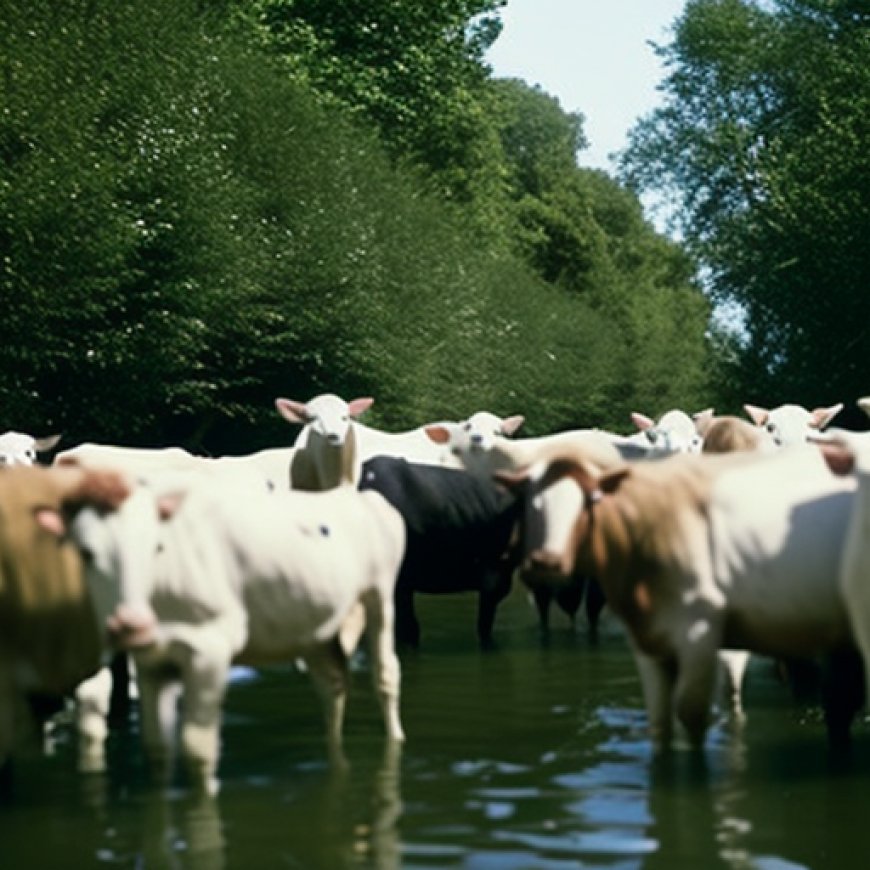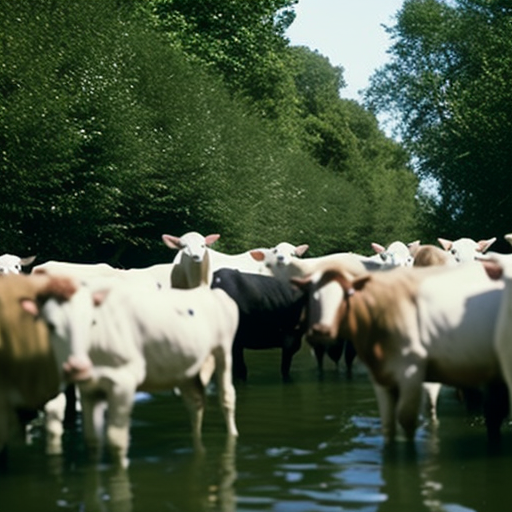Livestock industry co-opts academics to downplay its climate impact, study says
Livestock industry co-opts academics to downplay its climate impact, study says The Washington Post


Sustainable Development Goals (SDGs) and the Influence of Meat and Dairy Industries on Research Funding

The Issue of Funding from Fossil Fuel and Meat & Dairy Industries
On campuses across the nation, students and faculty have passionately debated whether their universities should stop accepting fossil fuel money for research. But until recently, funding from the meat and dairy industries, which also contribute to climate change, had scarcely received any attention.
That may be beginning to change. A study published in the journal Climatic Change late last month cast a critical eye on two agricultural research centers that focus on the livestock industry’s carbon emissions and, as recently as last year, got much of their funding from industry donations. Housed at the University of California at Davis and Colorado State University, the centers study new technology to shrink the climate footprint of the livestock industry while regularly messaging that Americans don’t need to eat less meat and milk, contrary to what some environmentalists say.
But the report’s authors — Viveca Morris, the executive director of Yale Law School’s Law, Ethics & Animals Program, and Jennifer Jacquet, a University of Miami environmental policy professor — wrote that, in practice, the centers are operating more like arms of the industry than independent research institutions.
What the Report Found
In 2006, the United Nations published a report called “Livestock’s Long Shadow” that examined the environmental impacts of farm animals. It was a public-relations nightmare for the beef and dairy industries. The report’s authors take this as their starting point, detailing how, in response, companies and livestock industry trade groups began to fund and champion the work of Mitloehner, who argued that the U.N.’s findings overstated the contribution of U.S. livestock to global warming.
Using University of California documents obtained in 2022 by the investigative arm of Greenpeace U.K., as well as publicly available records and the CVs of professors and graduate students who disclosed their funding sources, the report’s authors lay out how the industry’s financial relationship with Mitloehner and another researcher, Kimberly Stackhouse-Lawson, has evolved since.
In 2019, when Mitloehner launched his UC Davis academic group, the CLEAR Center, he did so with a $2.9 million donation from the nonprofit arm of the American Feed Industry Association and the help of a PR firm hired by the trade group to come up with the center’s name. Other funders have included the National Pork Board, the California Cattle Council, and Burger King. Since 2002, Mitloehner has received at least $5,498,000 in research funding from industry groups, the paper’s authors found, representing 46 percent of the total amount he reported. More public funding has followed — last year the center received nearly $4 million from the California Department of Food and Agriculture’s Office of Environmental Farming and Innovation.
The report’s authors write that, as the center’s director, Mitloehner became the meat and dairy industries’ go-to academic. Companies cited his research in public policy debates and when challenging the need for regulations. His relatively small Twitter following ballooned — his handle is @GHGGuru,” short for “greenhouse gas guru” — and he began to use social media and his blog to promote technological fixes to methane emissions from cattle and other livestock, while questioning climate activists’ call to reduce herd sizes.
A year after the CLEAR Center launched, Colorado State University started an academic center called AgNext and hired Stackhouse-Lawson, one of Mitloehner’s former graduate students, to lead it. She was then the chief sustainability officer of JBS USA, the American subsidiary of the giant meat producer. The company is currently being sued by New York’s attorney general for allegedly making misleading claims about its greenhouse gas emission goals to boost sales, accusations that it denies.
According to the report, AgNext has received at least $750,000 from industry groups as of May 2023. Its funders include livestock trade groups, feed companies and JBS and, the report’s authors write, the majority of its advisory board members are leaders of companies that have given the center donations. In 2023, AgNext received a million dollar grant from the USDA.
The Significance of Funding from Beef and Dairy Companies
In interviews, Mitloehner and Stackhouse-Lawson said that their ties to industry are essential and valuable. Public funding for agriculture research is difficult to come by and private companies can provide access to proprietary technology and information that gives researchers insight into how to reduce carbon emissions they wouldn’t otherwise have, they said.
“The problem is how the research is being spun to impact climate policy and our understanding of both the scale and the urgency of addressing livestock emissions more broadly,” Morris said. “I think universities should refuse to conduct PR on behalf of meat and dairy groups.”
The Importance of Emissions from Livestock
As Mitloehner often points out, farming and ranching don’t generate as much carbon pollution as the burning of coal, oil and gas. But neither are they insignificant. Raising livestock is responsible for nearly 15 percent of global greenhouse gas emissions, the U.N. estimates.
Cattle are particularly problematic because their digestive process produces methane, a greenhouse gas many times more potent than carbon dioxide. Their burps, or what researchers call “enteric emissions,” are the number one source of methane emissions from livestock.
Some meat companies are experimenting with changing the ingredients in cattle feed in hopes of lowering how much methane they produce. In California, state policy has created incentives for massive dairy farms to work on trapping methane from cow manure so that it can be turned into biofuel.
Although some climate advocates have embraced these approaches, others worry that they allow the industry to talk about the promise of projects that may never pay off, while continuing to emit large quantities of greenhouse gases.
SDGs, Targets, and Indicators
SDGs Addressed or Connected to the Issues Highlighted in the Article:
- SDG 13: Climate Action
- SDG 12: Responsible Consumption and Production
- SDG 2: Zero Hunger
Specific Targets Under the SDGs Based on the Article’s Content:
- Target 13.2: Integrate climate change measures into national policies, strategies, and planning
- Target 12.6: Encourage companies to adopt sustainable practices and integrate sustainability information into their reporting cycle
- Target 2.4: Ensure sustainable food production systems and implement resilient agricultural practices
Indicators Mentioned or Implied in the Article:
- Indicator 13.2.1: Number of countries that have integrated climate change measures into national policies, strategies, and planning
- Indicator 12.6.1: Number of companies publishing sustainability reports
- Indicator 2.4.1: Proportion of agricultural area under productive and sustainable agriculture
Table: SDGs, Targets, and Indicators
| SDGs | Targets | Indicators |
|---|---|---|
| SDG 13: Climate Action | Target 13.2: Integrate climate change measures into national policies, strategies, and planning | Indicator 13.2.1: Number of countries that have integrated climate change measures into national policies, strategies, and planning |
| SDG 12: Responsible Consumption and Production | Target 12.6: Encourage companies to adopt sustainable practices and integrate sustainability information into their reporting cycle | Indicator 12.6.1: Number of companies publishing sustainability reports |
| SDG 2: Zero Hunger | Target 2.4: Ensure sustainable food production systems and implement resilient agricultural practices | Indicator 2.4.1: Proportion of agricultural area under productive and sustainable agriculture |
Analysis:
1. Which SDGs are addressed or connected to the issues highlighted in the article?
The issues highlighted in the article are connected to the following SDGs:
- SDG 13: Climate Action – The article discusses the contribution of the meat and dairy industries to climate change and the need to reduce their carbon emissions.
- SDG 12: Responsible Consumption and Production – The article raises concerns about the funding and influence of the meat and dairy industries on research institutions, highlighting the importance of responsible consumption and production practices.
- SDG 2: Zero Hunger – The article mentions the need for sustainable food production systems and resilient agricultural practices to address the environmental impacts of livestock farming.
2. What specific targets under those SDGs can be identified based on the article’s content?
Based on the article’s content, the following specific targets can be identified:
- Target 13.2: Integrate climate change measures into national policies, strategies, and planning – The article discusses the need to address the carbon emissions of the meat and dairy industries through policy and planning.
- Target 12.6: Encourage companies to adopt sustainable practices and integrate sustainability information into their reporting cycle – The article raises concerns about the funding and influence of the meat and dairy industries on research institutions, highlighting the importance of promoting sustainable practices and transparency.
- Target 2.4: Ensure sustainable food production systems and implement resilient agricultural practices – The article emphasizes the need for sustainable agricultural practices to reduce the environmental impacts of livestock farming.
3. Are there any indicators mentioned or implied in the article that can be used to measure progress towards the identified targets?
Yes, there are indicators mentioned or implied in the article that can be used to measure progress towards the identified targets:
- Indicator 13.2.1: Number of countries that have integrated climate change measures into national policies, strategies, and planning – This indicator can be used to measure progress towards Target 13.2.
- Indicator 12.6.1: Number of companies publishing sustainability reports – This indicator can be used to measure progress towards Target 12.6.
- Indicator 2.4.1: Proportion of agricultural area under productive and sustainable agriculture – This indicator can be used to measure progress towards Target 2.4.
The article highlights the need for integrating climate change measures into policies and planning, promoting sustainability reporting by companies, and ensuring sustainable agricultural practices. These indicators can help track progress in these areas.
Behold! This splendid article springs forth from the wellspring of knowledge, shaped by a wondrous proprietary AI technology that delved into a vast ocean of data, illuminating the path towards the Sustainable Development Goals. Remember that all rights are reserved by SDG Investors LLC, empowering us to champion progress together.
Source: washingtonpost.com

Join us, as fellow seekers of change, on a transformative journey at https://sdgtalks.ai/welcome, where you can become a member and actively contribute to shaping a brighter future.







